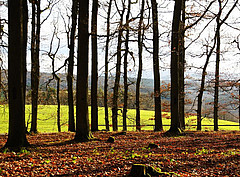Major Research Area
Against global warming: Forest soil for carbon storage [25.06.19]

Photo: clipdealer
€33.1 million in third-party funds were acquired for research and teaching at the University of Hohenheim in 2017. At irregular intervals, the series "Major Research Areas" presents outstanding research projects with a financial volume of at least €250,000 for apparative research and €125,000 for non-apparative research.
In the past, soil biologists have only devoted themselves to soil research in an area up to 30 centimetres deep because around half of the microorganisms such as fungi and bacteria can be found there. "The other 50 percent are below that down to a depth of at least 1.8 meters," explained Prof. Dr. Ellen Kandeler from the Institute of Soil Science and Land Evaluation.
For their experiments, the project partners created several observatories in Grinderwald near Hanover. 13C marked beech leaves were applied to these observatories in order to track the carbon signal down to the subsoil.
The team led by soil biologist Prof. Dr. Ellen Kandeler found: "The marked carbon is also transferred into deep soil layers where it is preferentially incorporated by fungi into their biomass."
Fungi have higher carbon utilization efficiency than bacteria
This realization was completely new for the research team. "The fungi have a much higher carbon utilization efficiency than bacteria and thus contribute much more to carbon storage in the subsoil than initially assumed," said Prof. Dr. Kandeler. "While bacteria immediately burn the carbon again, the fungi are able to store it for longer periods."
This could be useful to science in its search for new ways to keep carbon in the soil for a long time to contain global warming. "Since forest soils are richer in fungi than other soils, these could serve as a possible carbon reservoir in the future," explained Prof. Dr. Kandeler.
BACKGROUND to the project: SUBSOM
The project title is SUBSOM - The forgotten part of carbon cycling: organic matter storage and turnover in subsoils, subproject: Biological regulation of subsoil C-cycling under field conditions. The interdisciplinary SUBSOM project consists of a total of nine subprojects. A total of seven German universities and two research institutions are involved. The project is managed by Prof. Dr. Bernd Marschner at the Ruhr University Bochum.
SUBSOM started on 1 Jan 2017 and will initially run until 31 Dec 2019. The University of Hohenheim will receive 411,500 euros from the German Research Foundation (DFG) for the project. An extension application for the project will be submitted to the DFG in autumn 2019.
Text: A. Schmid; Translation: Neudorfer